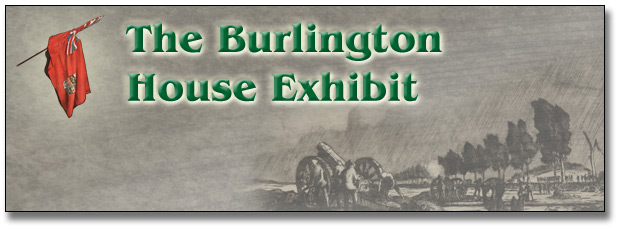
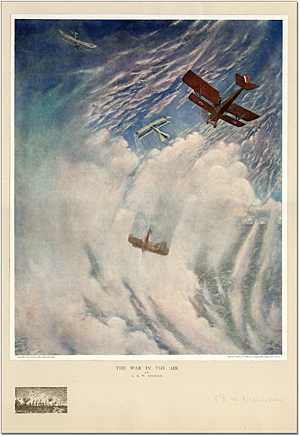
Click to see a larger image (395K)
The War In the Air, 1917
After C. R. W. Nevinson
Reference Code: C 334-2-0-0-9
Archives of Ontario, I0013656
The Canadian War Memorials Fund fonds (C 334) held by the Archives of Ontario consists of an incomplete set of prints (one of each of a limited number printed) that were in the Canadian War Memorials Exhibition held on the 4th of January at Burlington House, Piccadilly, London in 1919.
The prints were created as part of a fund-raising effort on behalf of the CWMF and a limited edition of 100 proofs were for sale to visitors viewing the exhibition or could be purchased directly from the CWRO.
In addition to the etchings a number of the large paintings on view at the exhibition had been reproduced in sheet form and 300 signed artists proofs of each painting were on sale. Nine of these images are also included in this virtual exhibit.
The print to the right, War in the Air by C. R. W. Nevinson, portrays an aerial confrontation involving one of Canada’s most famous aviation heroes, Billy Bishop. The original is now in the Canadian War Museum.
A souvenir catalogue was produced featuring the work that was for sale. The artworks in question were etchings by Lieutenants Cyril H. Barraud, Gerard de Witt and Gyrth Russell as well as by the artist Caroline H. Armington.
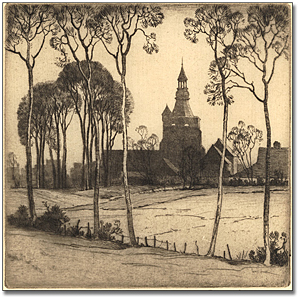
Click to see a larger image (186K)
View of the town of Meteren, south of Ypres,
from the Canadian Bombing School
February, 1916
Lieut. C. H. Barraud
Reference Code: C 334-1-2-0-13
Archives of Ontario, I0003112
Lieutenant de Witt (6th Canadian Siege Battery) was one of the official war artists attached to the Canadian War Records Office as were Lieutenants Barraud and Russell; the artist Caroline Armington was born in Brampton, Ontario and had been resident in Paris since 1900 remaining in France until her death in 1939.
|
Meteren |
|
Mine Crater on the Road to Mons |
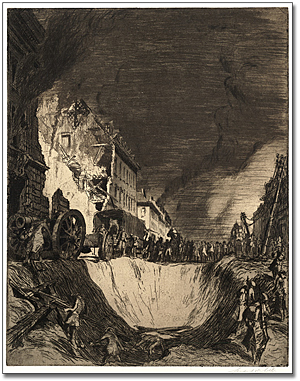
Click to see a larger image (247K)
Mine crater on the road to Mons, [ca. 1918]
Gerard de Witt
Reference Code: C 334-1-3-0-4
Archives of Ontario, I0013636
Also included in this exhibit are artworks by the Canadian artists Dorothy Stevens, C. W. Jefferys and others.
These particular images were not included in the 1919 souvenir package but were most probably created for the collection of the CWMF.
The Burlington House exhibit was by all accounts a great success. The major attraction of the exhibition was Augustus John’s ten-by-forty foot charcoal drawing “The Canadians Opposite Lens”. To observers at the exhibition, this massive drawing captured everything that could be imagined about war. Along with canvases, watercolours and sculpture were dry-points, etchings and lithographs.
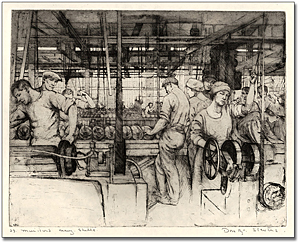
Click to see a larger image (273K)
Munitions Heavy Shells, 1919
Dorothy Stevens
Reference Code: C 334-1-5-0-18
Archives of Ontario, I0013281
The pre-exhibition publicity provided by the newspapers of Beaverbrook and the other press owners ensured that the exhibition was both a financial and critical success.
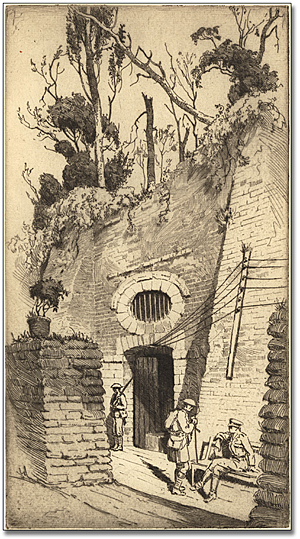
Click to see a larger image (269K)
The Ramparts, Ypres (used as Canadian
brigade headquarters), July, 1916
Lieut. C. H. Barraud
Reference Code: C 334-1-2-0-1
Archives of Ontario, I0003103
Returned soldiers were eager to show their families and friends where they had served and with the relaxation of censorship in 1919, the public could also see, through the images displayed, scenes of war that had long been denied them.
|
The Ramparts, Ypres The Ramparts of Ypres have figured largely in recent Canadian history, and Mr. Barraud's fine etching records the entrance to one of the chambers in the Ramparts used as Brigade Headquarters. This sketch was made in July 1916. |
It should be noted that the number of British war artists whose work was displayed at the Burlington House exhibition far outnumbered the number of Canadian artists. But there is no doubt that the work of the Canadian artists such as Jackson with 35 oil panels and Varley's large canvases were well received and their standing as artists increased both within Britain and in Canada as a result of their efforts.
The exhibition consisting of art works solely representing action at the front was moved to New York where once again it was a success with large numbers coming to the Anderson Galleries to view the drawings, paintings and sculptures, even though none of the images reflected American involvement in the war.
From New York it moved to Toronto and in August 1919 was installed in an enlarged Canadian National Exhibition’s Fine Art Gallery. This was to be the first opportunity for the Canadian public to see the art that had been talked about and judge it for themselves.
The Toronto exhibition was a huge success with over 100,000 Canadians paying to enter the CNE to see the show.
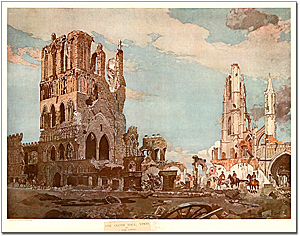
Click to see a larger image (311K)
The Cloth Hall Ypres, [ca. 1918] (detail)
After J. Kerr Lawson
Reference Code: C 334-2-0-0-2
Archives of Ontario, I0013649
After Toronto the exhibition
was moved to Montreal and from there to relative obscurity languishing
in various storage vaults until finally arriving at the National
War Museum in Ottawa. Another exhibition featuring work by 43
artists and concentrating on activities at the home front was
also circulating and opened at the Art Gallery of Toronto (now
the Art Gallery of Ontario) in Grange Park.
Wherever it travelled, the most popular image in the 1919 exhibition was John Byam Lister Shaw’s “The Flag”. Byam Shaw had chosen to represent the sacrifice of the Canadian soldier by placing the body draped with the Canadian red ensign between the paws of the British lion and surrounded by those for whom the sacrifice had been made.
Particularly poignant is the fact that two of the models in the painting were to die in World War II and that they were both Byam Shaw’s sons.
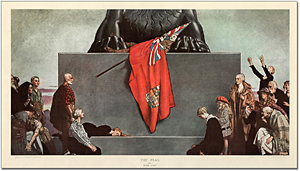
Click to see a larger image (159K)
The Flag, [ca. 1918] (detail)
After Byam Shaw
Reference Code: C 334-2-0-0-8
Archives of Ontario, I0013655
The Canadian War Museum in Ottawa has an extensive collection of the original works created for the Canadian War Memorial Fund project. They also hold several complete sets of souvenir prints. In addition, Art at the Service of War by Maria Tippett contains a good history of the program.
War Artists from the First World War | The Canadian War Memorials Fund
The Burlington House Exhibit | The Battlegrounds | The Home Front
War Artists at Work | Resources